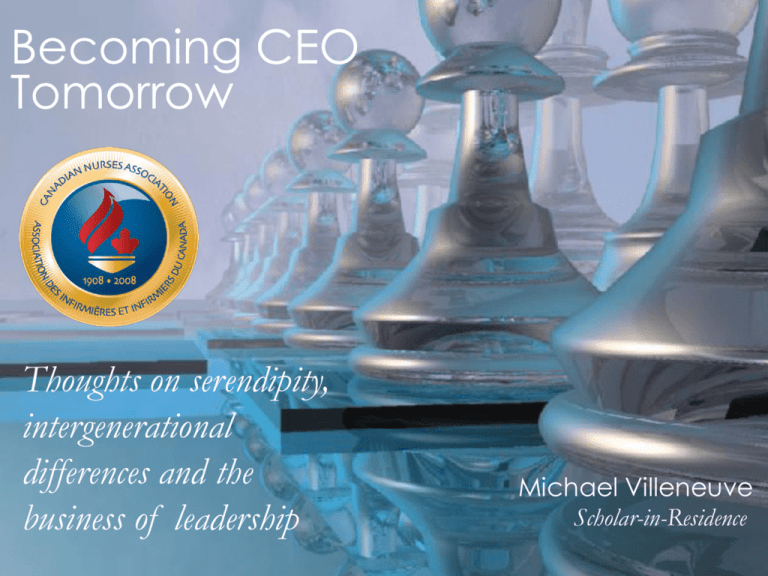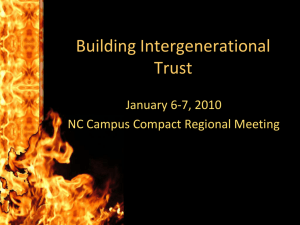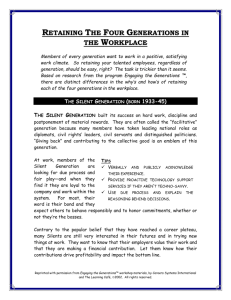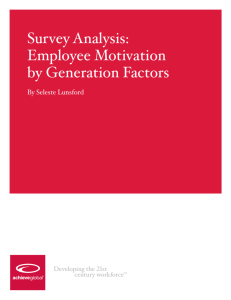Becoming CEO tomorrow
advertisement

Becoming CEO Tomorrow Thoughts on serendipity, intergenerational differences and the business of leadership Michael Villeneuve Scholar-in-Residence How did you navigate to your present leadership roles? The five levels of leadership 5 4 After Collins, 20022007. Five levels of leadership, from the Good to Great study. 3 2 1 Level 5 Executive Builds enduring greatness through a paradoxical blend of personal humility and professional will. Effective Leader Catalyzes commitment to and vigorous support of a clear and compelling vision, stimulating higher performance standards. Competent Manager Organizes people and resources toward the effective and efficient pursuit of pre-determined objectives. Contributing Team Member Contributes individual capabilities to the achievement of group objectives and works effectively with others in a group setting. Highly Capable Individual Makes productive contributions through talent, knowledge, skills, and good work habits. Power only tires those who don't exercise it. Be ready when opportunity comes... Luck is the time when preparation and opportunity meet. What tools did you find useful on your journey? Are there any gaps in the tools currently available to aspiring leaders? What qualities are needed in a health system leader? What is the “leadership” we are talking about? Strong leadership and management of/for workforces, teams, and delivery of services Strong leadership of broader systems and social agendas How do we move past GOGSATT? Are leaders born or made? Life Lessons Visionary Catalyst Decision-maker Inspirer Facilitator Implementer Evaluator Sister Elizabeth M. Davis LLD, PhD Cand Surviving the generations in schools and workplaces Working with traditionalists Honor the chain of command. Traditionalists have respect for authority and they expect it in return. Offer them job security. Traditionalists value the legacy they've built with your company. Value their experience. Use them as a resource to learn what has — and hasn't — gone right at the company in the past. Respect the insights they've gained from years of experience. Appreciate their dedication. Unlike the other generations, traditionalists are most likely to have taken a job and stayed with one company for their entire careers. Source: www.mayoclinic.com Working with baby boomers Show respect. Acknowledge that you have less experience and can learn from them. You may be quite bright, but you can always learn something new. Choose face-to-face conversations. Many baby boomers find e-mail or voice mail too impersonal and prefer speaking with someone face to face. Give them your full attention. Multitasking may help you accomplish a lot during the day. However, if you're typing away at an e-mail while your baby boomer colleague is talking to you about a project, chances are you'll wind up at odds with that colleague. Giving your full attention at the times it's needed actually may be more efficient in the long run. Source: www.mayoclinic.com Working with baby boomers Play the game. Workplace politics are a fact of life. As a generation Xer, you may be completely turned off by politics, but sometimes, you've just got to play the game. Baby boomers are diplomatic and particularly adept at navigating politically charged environments. Learn the corporate history. Unless you've been with a company since its inception, know that plenty of things transpired at the organization long before you set foot in the door. Find out what's gone right and what's gone wrong in the past — especially the lessons learned over the years. Nothing rankles a baby boomer more than a new employee who breezes in and wants to change things, with seemingly no thought given to what's gone on before. Source: www.mayoclinic.com Working with generation Xers Get to the point. Avoid corporate jargon, buzzwords and cliches that obscure what you're really trying to say. State your objectives clearly when communicating with generation Xers. Use e-mail. Take advantage of technology in your correspondence with a generation Xer. Save meetings for issues which require face-to-face communication, and use e-mail when the matter can be handled via a well-worded, concise written message. Give them space. Don't micromanage generation Xers. Generation Xers crave autonomy. Give them direction and then allow them to figure out the best way to get results. Source: www.mayoclinic.com Working with generation Xers Get over the notion of dues paying. As a baby boomer, you worked 60 hours a week to get ahead. Maybe you started at ground level and worked your way up in a company. You think members of younger generations ought to do the same. But generation X — which values a healthy work-life balance — typically isn't spending that many hours in the office. And they're getting ahead anyway. Lighten up. Remind yourself that it's OK for work to be fun. Generation Xers tend to think you're too intense and set in your ways. Source: www.mayoclinic.com Working with millenials Challenge them. Millennials want to work on things that really matter. Offer more responsibility as a reward for their accomplishments. Ask them their opinion. Millennials love to collaborate and be team players. They respond less enthusiastically to a dictatorial chain-of-command style of management. Find them a mentor. Millennials have an affinity and great respect for traditionalists. Establish mentormentee relationships between these two groups, and both parties will benefit. Provide timely feedback. Millennials are used to getting feedback instantaneously — at the touch of a button. In the workplace, they expect frequent, worthwhile feedback. Source: www.mayoclinic.com "If I could construct the next CEO of CNA…” Boldly courageous, big dreams, a revolutionary as well as an evolutionary, risk-taker, macro-leader Able to attract and retain followers through a tough journey Anchored in multiple generations Able to “let come” by “letting go” – including letting go of structures, people, traditions (e.g. week-long board meetings) Puts a strong management team in place More “traditional” organizations like CNA and CMA (and any having a regulatory function) are very different from places like CPRN or Microsoft. Such organizations need CEOs who are able to respectfully Life Lessons Creativity is thinking up new things. Innovation is doing new things. Theodore Levitt Great leadership – or lack of it – may have everything or nothing to do with any given outcome. People are not your most important asset. The right people are. Collins, 2005 You may know the right thing. But do you have the discipline to do the right thing? And equally important, to stop doing the wrong things? Collins, Good to Great, 2005 The central product of the health system is care – “human caring” is a key output. It’s not enough to understand it only from books. Leadership Moving up and out of flat fatalism The transcendental precepts Be attentive Be intelligent Be reasonable Be responsible Margaret Visser Beyond Fate, 2002 Be in love Bernard J.F. Lonergan, S.J. To download a pdf copy of Thank You Gracias Toward 2020: Visions for Nursing point your browser to: merci http://www.cna–aiic.ca







